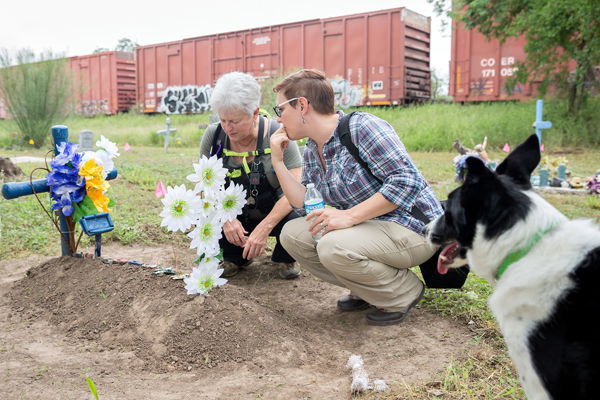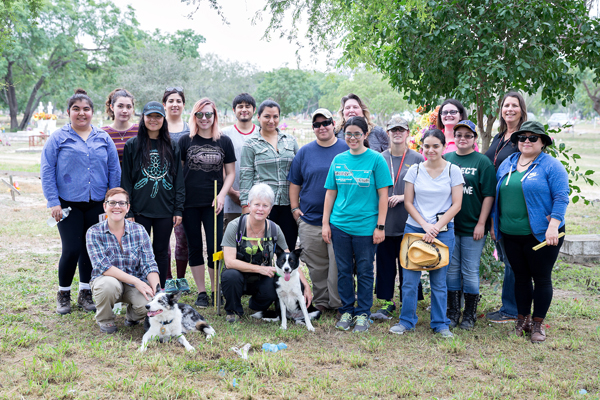- La Feria Community Holds Succesful Business Mixer Event
- Little Nashville to Take Place in Downtown Mercedes
- Lions Basketball Captures District Gold
- La Feria ISD Students Compete in Regional Chess Tournament
- Lions End First Half of 32-4A on a High Note
- La Feria ISD Held Another Successful Parent Conference
- Strong Appearance for Lions at Hidalgo Power Meet
- LFECHS Students Get to Meet Local Actress
- Students Participate in Marine Biology Camp
- Two LFECHS Students Qualify for All-State Band
UTRGV-Hidalgo County Project Working to Restore Dignity, Identify Burial Plots at Abandoned Pauper Cemetery
- Updated: January 5, 2018

Dr. Sarah Rowe (at right), UTRGV assistant professor of sociology and anthropology, is seen here working with Lynne Engelbert (at left), a K9 search specialist from California with the Institute for Canine Forensics, and Piper, one of two search dogs, to help detect human remains at the Hidalgo County Pauper Cemetery. The cemetery closed in the early 1990s, leaving many graves unmarked and decades of records, including the names and locations of the deceased, lost or abandoned. Rowe is working with Hidalgo County to help recuperate that information, and the K-9 search dogs alone have been successful in finding at least 20 previously unidentified graves. The project is part of a service learning class in which some of Rowe’s students work to identify burial sites. (UTRGV Photo by Paul Chouy)
by J. Edward Moreno
EDINBURG, TEXAS – DEC. 21, 2017 — On Schunior Street, just east of Expressway 281, lie the remains of an estimated 1,000 former residents of the Upper Rio Grande Valley.
This is the Hidalgo County Pauper Cemetery, which opened in 1913 and offered free plots for county residents unable to afford a proper burial for their loved ones, or for individuals sadly unidentified at the time of their death.
The cemetery closed in the early 1990s, leaving many graves unmarked and decades of records, including the names and locations of the deceased, lost or abandoned.
However, Dr. Sarah Rowe, an anthropology professor at The University of Texas Rio Grande Valley, was contacted by Hidalgo County earlier this year to help recuperate that information.
“Ultimately, the goal is to make a publicly accessible database where someone can type in a name and see if that person is buried in the cemetery, a picture of the gravestone and where it is on the map,” Rowe said.
Daniel Flores, the building maintenance manager for Hidalgo County, said that when his department was tasked with the upkeep of the cemetery, he began doing some research about the grounds.
“We discovered that there were a number of unmarked graves, and something had to be done to correct that,” he said. “So I reached out to UTRGV for guidance.”
An archaeologist by training, Rowe’s work is focused on precolonial excavations in Ecuador. And while she won’t be doing any excavating on this project, she did acquire the help of human remains detection dogs from California to help find the bodies of some of the deceased.
The K-9 unit was successful in finding 20 previously unidentified graves.
So far, 700 of approximately 1,000 graves have been identified. Once all the graves are accounted for, they will begin searching through records to find out who was buried in each plot.
Rowe said one of the most prevalent themes in this project is social justice, and how the Hidalgo County Pauper Cemetery chronicles historic inequality in the Rio Grande Valley.
“A lot of the really prominent threads of how we see the Valley today or how we talk about issues – we can see that reflected in the cemetery population,” she said. “For example, most of the graves are in Spanish; very few have Anglo names. Also, we see a lot of children buried there. The Valley is medically underserved and has been for some time, so that might be why we see higher instances of infant or child mortality.”

Jasper and Piper, border collies with the Institute for Canine Forensics trained to detect old burial sites, have been helping in an effort by Dr. Sarah Rowe, UTRGV assistant professor of sociology and anthropology, and some of her students to identify the unmarked burial sites and remains. The cemetery has been closed since the 1990s and has fallen into neglect. (UTRGV Photo by Paul Chouy)
THE PROJECT
Rowe is carrying out the search and research with the help of 17 students in her Service Learning course. The course is being offered again in the spring and is listed as a special topics in anthropology course called “Public Archaeology Fieldwork.”
Students often have to travel to gain field experience, she said, so being able participate in a project locally is invaluable.
“This is a great opportunity for students since it is actually located here,” she said. “I’ve been very impressed at the impact that experiential learning can have on the students. I’ve seen them take ownership and responsibility of the project and the material in ways that I haven’t seen in a typical classroom.”
Some of the students involved in the pauper cemetery project have recorded their thoughts about it in a blog: https://hcpcp.wordpress.com/blog/

Dr. Sarah Rowe (kneeling, far left), UTRGV assistant professor of sociology and anthropology, is seen here with search specialists from the Institute for Canine Forensics Lynne Engelbert (kneeling, at right) and Adela Morris (back row, fourth from left), along with search dogs Jasper and Piper and UTRGV students in Rowe’s service learning class, all of whom are helping to identify burial sites at the abandoned Hidalgo County Pauper Cemetery. The cemetery closed in the early 1990s, leaving many graves unmarked and many identification records lost or abandoned. (UTRGV Photo by Paul Chouy)


